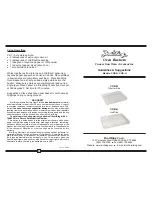
Power Supply Notes
All low-current ground-fault sensors are sensitive devices that
require reasonable care in system design to avoid false trips caused
by high electrical noise levels. Keep in mind that the best way to
reduce noise in a system is to suppress it at its source.
•
Keep the sensor power isolated from noisy circuits.
•
Do not power the sensor with the same circuit that switches con-
tactors or other high current inductive loads.
System Grounding
Good design practice and code require that all AC power systems
be grounded. The EGF Series sensors are designed to work on
grounded AC power systems. They may not operate properly on
ungrounded systems.
Specifications
Specification
Value
Power Supply
120 VAC (Operates from 66-132 V)
24 VAC/DC (Operates from 19.2-28.8 V)
Voltage Range
Up to 1,500 VAC (Monitored Circuit)
Power Consumption
2.5 W
Output
Latching Electromechanical Relay
Normally Open Models Latch Closed Upon Sensed Fault
Current
Normally Closed Models Latch Open Upon Sensed Fault
Current
Output Rating
1.0 A @ 120 VAC
2.0 A @ 30 VAC
Response Time
At 5% Over Setpoint: 200 ms
At 50% Over Setpoint: 60 ms
At 500% Over Setpoint: 15 ms
Setpoint Range
Selectable by Model
Fixed Setpoints: 50, 100 mA
Adjustable Setpoints: 5, 10, 30 mA (By Jumper)
Setpoint Adjustment
See “Adjust Setpoint” in “Operation” Section
Frequency Range
50-400 Hz (Monitored Circuit)
Housing
UL94 V0 Flammability Rated
Dimensions
Case: 2.5 in. H x 2.8 in. W x 1.5 in. D (64 x 71 x 38 mm)
Aperture: 0.75 in. (19 mm)
LED
Green = Power Supply Energized
Red = Relay Has Operated
Environmental
Operating Temperature: +5 to +158°F (-15 to +70°C)
Humidity: 0-95% RH, Non-Condensing
Approvals
UL Recognized, E313337
CE
RoHs Compliant
Ttsoing
To test operation, gently press the TEST button. This simulates a fault
and tests the internal switching circuits. After the test is complete,
reset the sensor with a momentary dry contact on Terminals 5 and
6. CAUTION: Any circuit connected to the sensor will be operated.
Adjusoing StopNino
While not as precise as having it set at the factory, the setpoint can be
adjusted in the field. See wiring diagram for location of potentiometer.
The best way to adjust the trip point is to develop a load of the mag-
nitude at which you want the sensor to trip. A resistor of 4,000 Ohms
should provide a load of 30 mA at 120 VAC, or a night light bulb of 4
watts should relate to 33 mA. With the load energized and passing
through the sensing aperture, turn the potentiometer clockwise until the
sensor trips. Then, back one-eighth of a turn and the setpoint should be
correct.
When used with an external current transformer (CT), the sensor will
be set to trip at a point much lower than without the CT. This set point
adjustment should be done with the load passing through the CT in that
application.
3
EATON
www.eaton.com
Instructions Publication
P51923
Effective July 2017
CurrentWatch™ EGF Series Ground Fault Sensors
120 VAC or 24 VAC/DC, N.O. or N.C. SPST
Latching Relay Output






















